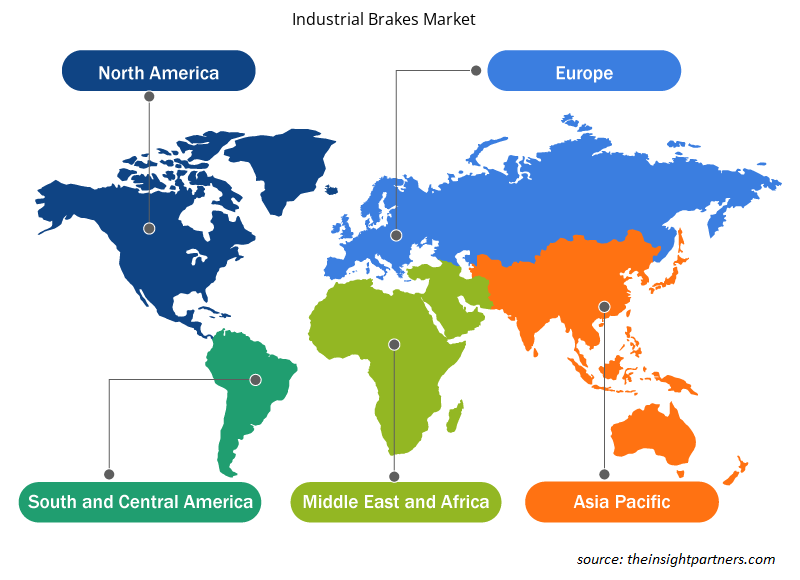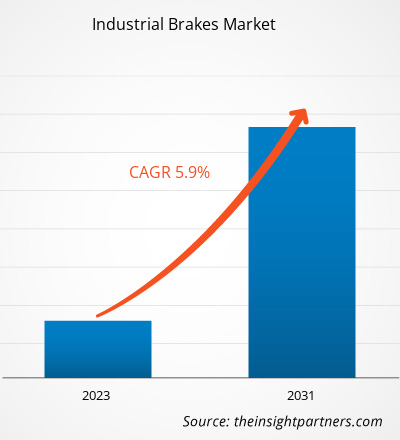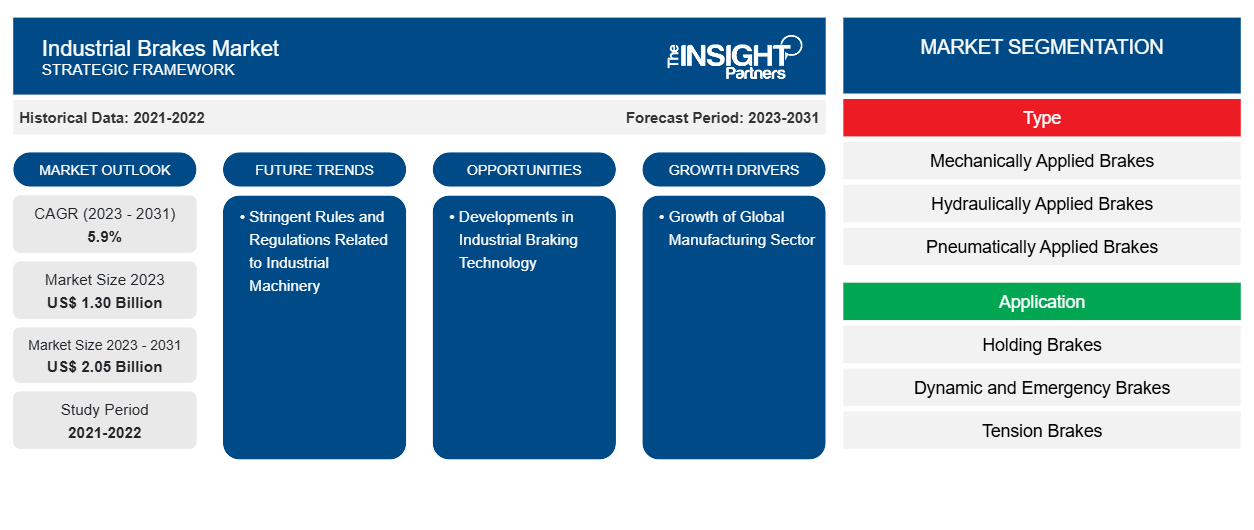Das Marktvolumen für Industriebremsen soll von 1,30 Milliarden US-Dollar im Jahr 2023 auf 2,05 Milliarden US-Dollar im Jahr 2031 anwachsen. Für den Markt wird für den Zeitraum 2023–2031 eine durchschnittliche jährliche Wachstumsrate (CAGR) von 5,9 % erwartet.
Eine Industriebremse ist ein Reibungsgerät, das dazu dient, eine sich drehende Trägheitslast anzuhalten oder ein Bauteil in einer festen Position zu halten. In den meisten Fällen wird die Trägheitslast durch viele sich drehende Bauteile verursacht, die angehalten werden müssen. Um etwas zu verlangsamen, wandeln sie die durch Reibung zwischen zwei Oberflächen erzeugte kinetische Energie in Wärme um. Industriebremsen unterscheiden sich von Autobremsen dadurch, dass sie in einer Vielzahl von Industriemaschinen eingesetzt werden. Industriebremsen funktionieren bei jedem Wetter, erfordern aufgrund der geringeren Anzahl beweglicher Bauteile weniger Wartung und lassen sich für verschiedene Anwendungen leicht modifizieren. All diese Gründe werden im Prognosezeitraum wahrscheinlich die Nachfrage nach Industriebremsen weltweit ankurbeln.
Industriebremsen bieten zahlreiche Vorteile, einer davon ist die geringe Anzahl an benötigten Teilen und Ersatzteilen. Weitere Vorteile sind die einfache Hygiene aufgrund des einteiligen Designs, eine hohe Kapitalrendite aufgrund der längeren Lebensdauer von Industriebremsen und die Fähigkeit, unter rauen Bedingungen zu arbeiten. Darüber hinaus wird erwartet, dass die zunehmende Industrialisierung und die zunehmenden staatlichen Investitionen in die Industriesektoren zur Förderung der Produktion im Prognosezeitraum einen erheblichen Einfluss auf den Markt für Industriebremsen haben werden.
Marktanalyse für Industriebremsen
Zu den wichtigsten Akteuren im globalen Ökosystem des Marktes für Industriebremsen gehören Rohstofflieferanten, Hersteller von Industriebremsen und Endverbraucher. Die steigende Nachfrage nach fortschrittlichen Bremsen in Fertigungsanlagen verschiedener Branchen ist einer der Hauptfaktoren, die die Nachfrage nach Industriebremsen antreiben. Die Rohstofflieferanten bieten mehrere verschiedene Einheiten für verschiedene Arten von Industriebremsen an, wie z. B. mechanisch betätigte Bremsen, hydraulisch betätigte Bremsen, pneumatisch betätigte Bremsen und elektrisch betätigte Bremsen. Darüber hinaus beeinflusst die Verwendung von Industriebremsen durch Endverbraucher zur Erleichterung der Arbeit der Industrieanlagen, indem sie ihnen die erforderliche Geschwindigkeit, Beschleunigung und Verzögerung verleihen, die Nachfrage nach Industriebremsen weiter.
Marktübersicht für Industriebremsen
Industriebremsen werden häufig beim Bau von Schwermaschinen und Industriefahrzeugen verwendet, beispielsweise in Baggern, Bulldozern, Baggerladern, Kompaktladern und anderen. Industriebremsen werden auch in verschiedenen Lebensmittelverarbeitungsanlagen, medizinischen Geräten , hydraulischen Maschinen in Industrieanlagen, im Automobilbau und anderen Anwendungen verwendet. Der Markt für Industriebremsen hat im Asien-Pazifik-Raum den größten Anteil, da dort mehrere kleine und mittelgroße Hersteller, gefolgt von den führenden Akteuren, vertreten sind. Zu den Herstellern von Industriebremsen im Asien-Pazifik-Raum zählen unter anderem Altra Industrial Motion Corp., ADVICS CO., LTD., Akebono Brake Industry Co., Ltd., AMETEK Inc., Eaton Corporation plc, Emco Precima Engineering Pvt Ltd. und andere. Diese Hersteller beliefern verschiedenste Branchen rund um den Globus mit Industriebremsen.
Passen Sie diesen Bericht Ihren Anforderungen an
Sie erhalten kostenlose Anpassungen an jedem Bericht, einschließlich Teilen dieses Berichts oder einer Analyse auf Länderebene, eines Excel-Datenpakets sowie tolle Angebote und Rabatte für Start-ups und Universitäten.
-
Holen Sie sich die wichtigsten Markttrends aus diesem Bericht.Dieses KOSTENLOSE Beispiel umfasst eine Datenanalyse von Markttrends bis hin zu Schätzungen und Prognosen.
Treiber und Chancen auf dem Markt für Industriebremsen
Wachstum des globalen Fertigungssektors
Seit Beginn der industriellen Revolution haben technologische Fortschritte zu einem enormen Anstieg der industriellen Produktionskapazitäten geführt; infolgedessen ist die Fertigung weltweit auf dem Vormarsch. Laut PricewaterhouseCoopers (PwC) sind wachsende Volkswirtschaften, Arbeitsqualität, Steuerpolitik, regulatorische Rahmenbedingungen sowie Transport- und Energiepreise die Faktoren, die das Comeback dieses Sektors katalysiert haben. Infolge des expandierenden Fertigungssektors florieren auch die abhängigen Märkte, darunter Anbieter mechanischer Ausrüstung. Mit dem Aufkommen neuer Verbraucherkategorien in Entwicklungsländern werden sich Hersteller auf der ganzen Welt wahrscheinlich erhebliche neue Aussichten bieten; darüber hinaus erzeugen Innovationen neue Anforderungen und treiben so den Einsatz moderner Ausrüstung und Systeme in Fertigungseinheiten voran.
Strenge Regeln und Vorschriften für Industriemaschinen
Maschinen sind für den Produktionsprozess notwendig, doch Unfälle während ihres Betriebs können zu Verbrennungen, Erblindung und Amputationen führen. Schutzmaßnahmen, Standardisierung von Betriebsverfahren und gründliche Schulungen können dazu beitragen, die Sicherheit des Personals zu gewährleisten. Regierungen und Organisationen auf der ganzen Welt verändern ihre Betriebsabläufe, indem sie Emissions- und Sicherheitsstandards in Produktionsanlagen implementieren. Die Bußgelder der Occupational Safety and Health Administration (OSHA) für Verstöße gegen Sicherheitsstandards beliefen sich im Geschäftsjahr 2018 auf insgesamt mehr als 50 Millionen US-Dollar. Daher entwickelt die US-Regierung einen langfristigen Regulierungsplan zur Förderung des Fertigungssektors und zur Steigerung seines Beitrags zum BIP.
Entwicklungen in der Industriebremsentechnik
Beim Entwurf von Gerätesystemen ist es wichtig, darüber nachzudenken, wie sich das Bremssystem auf den Betrieb nachfolgender Maschinen auswirkt. Ausfallsichere Bremsen helfen dabei, die Bewegung der Maschine bei Unfällen, Leistungsstörungen oder Stromausfällen usw. schnell zu stoppen. Unternehmen arbeiten auch an hydraulischen Lösebremsen, also federbelasteten Bremssystemen, die hydraulische Energie nutzen, um ein einstellbares Drehmoment zu erzeugen. Der Bedarf an Industriebremsen ist bei Bergbauwinden, Brückenkränen, Stahlwalzsystemen und anderen ähnlichen Geräten hoch. Darüber hinaus bergen die Lagerhaltung, die Medizin, Stahlwerke und die Lebensmittelverarbeitung ein erhebliches Potenzial für den Markt für Industriebremsen. Unternehmen arbeiten aktiv an federbelasteten Bremsen mit hohen zulässigen Bremsenergien, hohen Drehmomenten und Verschleißfestigkeit. Kor-Pak, ein OEM und Distributor von Industriebremsen und -kupplungen, entwickelt beispielsweise End-to-End-Bremssysteme für die Bergbau- und Fertigungsindustrie.
Segmentierungsanalyse des Marktberichts für Industriebremsen
Wichtige Segmente, die zur Ableitung der Marktanalyse für Industriebremsen beigetragen haben, sind Temperaturtyp, Lagertyp und Anwendung.
- Je nach Typ ist der Markt in mechanisch betätigte Bremsen, hydraulisch betätigte Bremsen, pneumatisch betätigte Bremsen, elektrisch betätigte Bremsen und andere unterteilt. Mechanisch betätigte Bremsen wenden Kraft an, meist Reibung, um eine Maschine oder ein Objekt zu verlangsamen oder anzuhalten. Die Kraft wird auf einen Körper ausgeübt, der sich dreht oder linear bewegt, beispielsweise eine Achse, Welle oder ein Rad. Mechanische Bremsen werden in der Materialhandhabung, Fertigung und anderen Kraftübertragungsanwendungen eingesetzt und am häufigsten mit Automobilen in Verbindung gebracht. Zum Ein- und Auskuppeln von Wellen werden mechanische Bremsen häufig in Verbindung mit einer mechanischen Kupplung verwendet. Zum Abbremsen verwenden Reibungsbremsen eine grobe und zähe Substanz (einen Bremsbelag), die gegen einen sich bewegenden Körper gespannt oder gedrückt wird. Reibungsbasiertes Bremsen erzeugt viel Wärme und erheblichen Lärm, was die beteiligten Oberflächenbereiche beschädigt.
- Basierend auf der Anwendung ist der globale Markt für Industriebremsen in Haltebremsen, dynamische und Notbremsen sowie Zugbremsen unterteilt. Motorhaltebremsen sind dafür verantwortlich, die Position des Motors beizubehalten, wenn die Leistungsstufe ausgeschaltet ist. Die Haltebremse ist weder eine Sicherheitsfunktion noch eine Wartungsbremse. Diese Bremse wird in der Fabrikautomatisierung, in medizinischen Geräten, Aufzügen und Rolltreppen, Baumaschinen, Robotern und Werkzeugmaschinen verwendet. Viele Unternehmen bieten Haltebremsen für verschiedene Anwendungen und Industrieumgebungen an. Beispielsweise bietet Vortex Engineering Works Federhaltebremsen für den Einsatz in der Textilindustrie an.
- Je nach Branche wird der Markt in die Branchen Fertigung, Metall und Bergbau, Bau, Energieerzeugung, Schifffahrt und Schifffahrt usw. unterteilt.
Marktanteilsanalyse für Industriebremsen nach geografischer Lage
Der geografische Umfang des Marktberichts für Industriebremsen ist hauptsächlich in fünf Regionen unterteilt: Nordamerika, APAC, Europa, Naher Osten und Afrika sowie SAM.
Die anhaltende Entwicklung des Industriesektors in den Ländern des asiatisch-pazifischen Raums trägt zu ihrem wirtschaftlichen Wohlstand bei. Dieser Wandel hat zu steigendem Wohlstand, Urbanisierung und Bevölkerungswachstum geführt. Darüber hinaus ist der asiatisch-pazifische Raum für einen erheblichen Anteil des weltweiten Energieverbrauchs verantwortlich, wobei der Industriesektor den größten Teil des regionalen Energieverbrauchs ausmacht. Die Region umfasst 58 Volkswirtschaften und beherbergt über 60 % der Weltbevölkerung. Laut ADB-Jahresbericht 2018 stieg sein Anteil am globalen Bruttoinlandsprodukt (BIP PPP) in Kaufkraftparität von 30,1 % im Jahr 2000 auf 42,6 % im Jahr 2017, und drei Länder – China, Japan und Indien – machten 2017 mehr als 70 % der gesamten Produktion der Region aus. Im Jahr 2014 stieg der Gesamtenergieverbrauch des asiatisch-pazifischen Raums doppelt so schnell wie der Welt; er verbraucht mehr als 50 % der gesamten Energieversorgung der Welt und ist für etwa 55 % der weltweiten Kraftstoffemissionen verantwortlich.
Die Expansion des Industriesektors führt auch zu einem höheren Energieverbrauch und Treibhausgasemissionen. Der Einsatz energiesparender Alternativen in Unternehmen, die optimale Arbeitsbedingungen benötigen, erhöht die Nachfrage nach verschiedenen Arten von Industriebremsen. Darüber hinaus haben eine erhöhte Energiesicherheit, eine verbesserte Umweltqualität am Arbeitsplatz und die Schaffung neuer Arbeitsplätze durch die Einführung von Geschäftsaussichten im Zusammenhang mit Energieeffizienz ebenfalls zu einem Anstieg der Industrialisierung in der Region geführt und damit das Wachstum des Marktes für Industriebremsen vorangetrieben.
Regionale Einblicke in den Markt für Industriebremsen
Die regionalen Trends und Faktoren, die den Markt für Industriebremsen im Prognosezeitraum beeinflussen, wurden von den Analysten von Insight Partners ausführlich erläutert. In diesem Abschnitt werden auch die Marktsegmente und die Geografie für Industriebremsen in Nordamerika, Europa, im asiatisch-pazifischen Raum, im Nahen Osten und Afrika sowie in Süd- und Mittelamerika erörtert.

- Erhalten Sie regionale Daten zum Markt für Industriebremsen
Umfang des Marktberichts für Industriebremsen
| Berichtsattribut | Details |
|---|---|
| Marktgröße im Jahr 2023 | 1,30 Milliarden US-Dollar |
| Marktgröße bis 2031 | 2,05 Milliarden US-Dollar |
| Globale CAGR (2023 - 2031) | 5,9 % |
| Historische Daten | 2021-2022 |
| Prognosezeitraum | 2023–2031 |
| Abgedeckte Segmente |
Nach Typ
|
| Abgedeckte Regionen und Länder |
Nordamerika
|
| Marktführer und wichtige Unternehmensprofile |
|
Dichte der Marktteilnehmer für Industriebremsen: Auswirkungen auf die Geschäftsdynamik verstehen
Der Markt für Industriebremsen wächst rasant, angetrieben durch die steigende Nachfrage der Endnutzer aufgrund von Faktoren wie sich entwickelnden Verbraucherpräferenzen, technologischen Fortschritten und einem größeren Bewusstsein für die Vorteile des Produkts. Mit steigender Nachfrage erweitern Unternehmen ihr Angebot, entwickeln Innovationen, um die Bedürfnisse der Verbraucher zu erfüllen, und nutzen neue Trends, was das Marktwachstum weiter ankurbelt.
Die Marktteilnehmerdichte bezieht sich auf die Verteilung der Firmen oder Unternehmen, die in einem bestimmten Markt oder einer bestimmten Branche tätig sind. Sie gibt an, wie viele Wettbewerber (Marktteilnehmer) in einem bestimmten Marktraum im Verhältnis zu seiner Größe oder seinem gesamten Marktwert präsent sind.
Die wichtigsten auf dem Markt für Industriebremsen tätigen Unternehmen sind:
- Akebono Bremsenindustrie Co., Ltd.
- Altra Industrial Motion Corporation
- Ametek Inc.
- Anwendung neuer Technologien von Antec SAU
- Dellner Bubenzer Germany GmbH
- Hilliard Corporation
Haftungsausschluss : Die oben aufgeführten Unternehmen sind nicht in einer bestimmten Reihenfolge aufgeführt.

- Überblick über die wichtigsten Akteure auf dem Markt für Industriebremsen
Neuigkeiten und aktuelle Entwicklungen zum Markt für Industriebremsen
Der Markt für Industriebremsen wird durch die Erhebung qualitativer und quantitativer Daten nach Primär- und Sekundärforschung bewertet, die wichtige Unternehmensveröffentlichungen, Verbandsdaten und Datenbanken umfasst. Im Folgenden finden Sie eine Liste der Entwicklungen auf dem Markt für Innovationen, Geschäftserweiterungen und Strategien:
- Im März 2023 brachte die indische Marke TVS Apache Brakes ZAP-Bremsbeläge auf den Markt, die auf fortschrittlicher Technologie für Elektrofahrzeuge basieren. ZAP ist eine Bremsflüssigkeit, die entwickelt wurde, um die Anforderungen der Benutzer an Elektrofahrzeuge zu erfüllen. Sie verbessert die Korrosionsbeständigkeit, bietet Schutz und ermöglicht geräuschloses Bremsen für Elektrofahrzeuge. (Quelle: Eurofins, Pressemitteilung)
Marktbericht zu Industriebremsen – Umfang und Ergebnisse
Der Bericht „Marktgröße und Prognose für Industriebremsen (2021–2031)“ bietet eine detaillierte Analyse des Marktes, die die folgenden Bereiche abdeckt:
- Industriebremsen Marktgröße und Prognose auf globaler, regionaler und Länderebene für alle wichtigen Marktsegmente, die im Rahmen des Berichts abgedeckt sind
- Marktdynamik wie Treiber, Beschränkungen und wichtige Chancen
- Markttrends für Industriebremsen
- Detaillierte PEST-Analyse und SWOT-Analyse
- Marktanalyse für Industriebremsen, die wichtige Markttrends, globale und regionale Rahmenbedingungen, wichtige Akteure, Vorschriften und aktuelle Marktentwicklungen abdeckt.
- Markt für Industriebremsen: Branchenlandschaft und Wettbewerbsanalyse, einschließlich Marktkonzentration, Heatmap-Analyse, prominenten Akteuren und jüngsten Entwicklungen.
- Detaillierte Firmenprofile
- Historische Analyse (2 Jahre), Basisjahr, Prognose (7 Jahre) mit CAGR
- PEST- und SWOT-Analyse
- Marktgröße Wert/Volumen – Global, Regional, Land
- Branchen- und Wettbewerbslandschaft
- Excel-Datensatz
Aktuelle Berichte
Erfahrungsberichte
Grund zum Kauf
- Fundierte Entscheidungsfindung
- Marktdynamik verstehen
- Wettbewerbsanalyse
- Kundeneinblicke
- Marktprognosen
- Risikominimierung
- Strategische Planung
- Investitionsbegründung
- Identifizierung neuer Märkte
- Verbesserung von Marketingstrategien
- Steigerung der Betriebseffizienz
- Anpassung an regulatorische Trends























 Kostenlose Probe anfordern für - Markt für Industriebremsen
Kostenlose Probe anfordern für - Markt für Industriebremsen